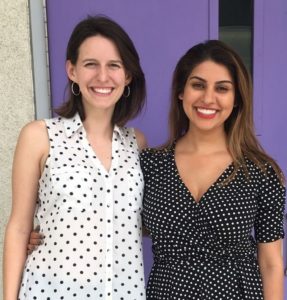
Photo: Cooper Haskins (left), 4th Grade Teacher, RCL at Dolores Huerta Elementary School; and Sabrina Sheikh (right), 3rd-5th Special Day Class Teacher, RCL at Dolores Huerta Elementary School.
Recently we connected with Cooper Haskins and Sabrina Sheikh, Teachers and Restorative Communities Leads (RCL) at Dolores Huerta Elementary School, about deepening relationships with their peers. Here’s what they shared:
What were some of your takeaways from the strike?
The strike gave our staff the opportunity to come together and deepen relationships with each other. During the school year, time we spend preparing lessons makes it difficult to leave the four walls of our classroom. However, during the strike, sitting in the rain together for over a week taught us how important it is to spend time getting to know the people with whom we work. Personally, we learned so many beautiful things about our colleagues. When we returned to our classrooms after the strike, we realized that we needed to use our restorative justice work to keep that relationship-building momentum going, so that we could continue to support each other and be the best we can be for our students.
How did you begin leading Restorative Communities sessions at your school post-strike?
During the February Restorative Communities Leads (RCL) Seminar, Tanya Franklin, Senior Director of School Culture at the Partnership, led an incredible restorative justice circle to help all the RCLs process the experience of the strike together. We felt it was important to host a circle at our school that acknowledged what happened and gave space for all voices to be heard.
What was the most impactful part about leading restorative justice work at your school?
Leading restorative justice work at our school after the strike helped our staff process what was both a stressful and very inspiring event, and enabled our staff to deepen their bonds with each other. One of the most impactful activities we had in school post-strike was a “Superman” activity during our Teacher Professional Development Day. We created templates that were taped on the backs of our colleagues. Then we gave them time to write compliments for one another on the templates. We followed that activity with a circle and asked how it felt to receive those compliments. Some teachers were emotional because it meant so much to them. After the activity, teachers said that they would try it in their classrooms and later reported that their students also benefited from this positive restorative activity. Quick team building activities like this are a reminder that both in adult and student learning, we need to make time to connect and affirm one another.
What are you looking forward to as we approach the end of the school year?
As we approach the end of the school year, it’s important to integrate opportunities to cultivate social emotional learning like relationship-building and growth mindset activities. To that end, we are looking forward to implementing Second Step, a Social Emotional Learning curriculum for elementary students. Also, we’re hoping to host an SBAC Motivational Assembly for our school!
If you are interested in learning more about the Partnership’s Restorative Communities Lead program, email Tanya Franklin at tanya.franklin@partnershipla.org.
